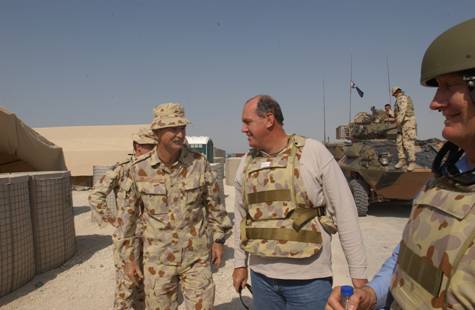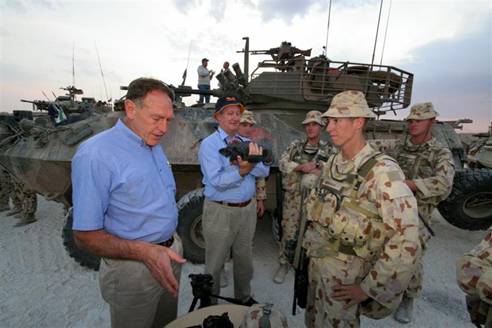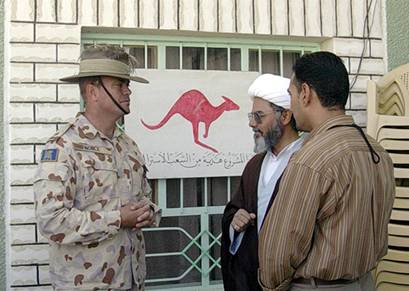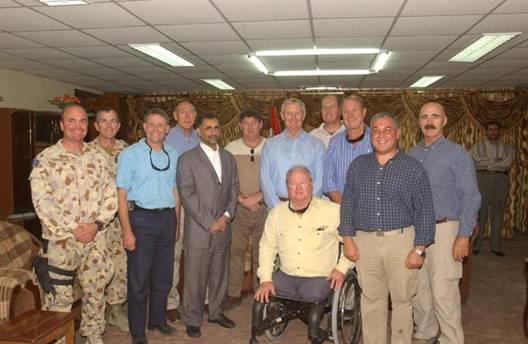Joint Standing Committee on Foreign Affairs, Defence and Trade
Visit to Australian Defence Forces Deployed to Support the Rehabilitation of Iraq
Chapter 5 Visit to the Al Muthanna Task Group
Background
Current Operations
The Al Muthanna Task Group
Equipment
Conduct of the Visit
Observations
Background |
5.1 |
With the withdrawal of the Army Special Forces Task Group (SFTG) from western Iraq in 2003 Australia ceased contributing directly to the security situation on the ground in Iraq. Australia’s military contribution within Iraq comprised the highly valued Australian Army Training Teams – Iraq (AATTI), a number of embedded military staff working with coalition Headquarters and a small group protecting Australia’s diplomatic and military staff in Baghdad. |
| 5.2 |
In February 2005 the Prime Minister announced that the Australian Government had agreed to a request from the British and Japanese Governments to assist with the provision of a secure environment for Japanese reconstruction work in the southern Iraq province of Al Muthanna . In response to the Government direction the ADF created the Al Muthanna Task Group (AMTG), an Army combined arms battlegroup based on units from the Army’s high readiness 1 st Brigade and also comprising an additional AATTI.1 |
| 5.3 |
The Al Muthanna province is part of the British area of operations and had previously been secured by the Dutch. Al Muthanna is a very large but relatively poor rural province, mainly populated by the Shiite community. The regional capital, As Samawah, is a city of approximately 250,000 people. The province has been one of the more stable locations in Iraq but
the security situation remains stable but unpredictable as locals remain frustrated with the slow pace of reconstruction. |
|
|
Current Operations |
The Al Muthanna Task Group |
| 5.4 |
The AMTG deployed to Iraq in April / May 2005. It is made up of 450 personnel, approximately 400 of whom are involved in security operations with the remaining 50 personnel training the new Iraqi Army. The Task Group outline structure is as follows:
- A Task Group Headquarters based on the Regimental HQ of the Army’s 2 nd Cavalry Regiment based in Darwin and augmented with offensive support coordination capabilities, additional intelligence staff and legal and policy advisers;
- Combat Team Eagle – a combined arms team with a mix of cavalry soldiers equipped with Australian Light Armoured Vehicle (ASLAV), and mechanised infantry soldiers for dismounted security tasks. Combat Team Eagle is described as “cavalry heavy” as the majority of its tasks are mobile security tasks such as convoy escorts, route clearances or mounted patrols;
- Combat Team Tiger – a combined arms team with a mix of infantry soldiers, supported by cavalry troops to provide armoured mobility. Tiger is described as “infantry heavy” as the majority of its tasks are dismounted security tasks such as facilities security and foot patrolling;
- A Combat Service Support company – a mixture of the sub elements needed to sustain Army operations such as maintenance personnel, medical staff and supply personnel; and
- A Civil Military Cooperation (CIMIC) unit tasked with the direct liaison with the local community and selecting and managing reconstruction projects provided by Australia.
|
| 5.5 |
The AATTI follows on from successful training team contributions in northern Iraq, northern Baghdad and in the initial teams which raised the first two Iraqi Army battalions in Kirkush to the east of Baghdad. There methods and lineage can be followed further back to the Australian Army Training Team – Vietnam. The AATTI is broadly structured as follows:
- A Brigade Headquarters support team; and
- Two Battalion support teams.
|
|
|
Equipment |
| 5.6 |
The AMTG conducts operations with the following major equipment types:
- The ASLAV family of vehicles which includes direct fire vehicles equipped with a 25mm cannon and sophisticated fire control systems, a Personnel Carrier suited to carriage of infantry or scouts and armed with a remote overhead weapon station, an armoured ambulance and an armoured recovery vehicle capable of towing a damaged vehicle to a safe location. The ASLAV has outstanding tactical mobility in the desert area of operations and has some of the most sophisticated night fighting aids available in Iraq.
- The Bushmaster Infantry Mobility Vehicle – an armoured truck capable of carrying support and logistic personnel in a protected, air conditioned cabin. The Bushmaster has proved to be reliable and capable of matching the mobility of the ASLAV in most conditions. It offers a good level of protection and excellent comfort for troops who spend many hours in the vehicles in extreme temperatures. The vehicle is very popular with both its operators and those who ride in the back.
|
 |
|
|
Conduct of the Visit |
| 5.7 |
The delegation visit to the AMTG was conducted as follows:
- the delegates were equipped with protective equipment and briefed by Close Personal Protection personnel at the Australian Force Level Logistic unit outside Kuwait city;
- the delegation flew by Australian C130 aircraft from Kuwait to Talil, a coalition airbase 90km south of the Australian area of operations where it was met by LTCOL Roger Noble, Commanding Officer of the AMTG and his Regimental Sergeant Major Warrant Officer Bob Aboud;
- the delegation was transported in Australian Bushmaster vehicles from Talil to Camp Smitty, home to AMTG;
- The delegation lunched with the local Japanese and British Commanders at Camp Smitty;
- The delegation travelled to As Samawah by Bushmaster, escorted by Combat Team Eagle, to meet with the provincial Governor;
- On return to Camp Smitty the delegation received a series of classified briefings from CO AMTG and his key leaders Majors Bye, Garraway, and Barras;
- The delegation had a BBQ dinner with those members of the task group that were not required for security tasks; and
- The delegation camped overnight with the Task Group before departing the following morning.
|
 |
|
|
Observations |
| 5.8 |
The delegation made the following observations during its stay with the AMTG:
- The AMTG is well led by a very capable group of officers and senior NCOs, headed by Lieutenant Colonel Roger Noble. Roger is to be commended for his performance and for his frank and informative briefings to the delegation.
- The AMTG has made a very positive contribution to the security of the Al Muthanna province. They are achieving their task of creating a secure environment for the Japanese reconstruction force by pre-empting problems in the area through a determined and well considered presence throughout the province.
- The Iraqi Army Brigade mentored by the AATTI is developing steadily. The Australian team has been a significant factor in the successful development of the Iraqi Brigade capability – supporting the development of facilities, doctrine and sourcing equipment as well as conducting training and mentoring commanders conducting operations.
- Morale in the task group is very high. The delegates were consistently briefed that the Australian Task Group had the best equipment in the coalition for the types of tasks being conducted and the delegates received no complaints about any of the support systems in place for the soldiers and their families despite pressing for such concerns.
- The cont inge nt has been stressed during the period in which members were released for their mid tour leave (Relief Out of Country Leave – ROCL). The AMTG command team strongly support the need for ROCL, a condition of service equal to the best provided by any nation and an important factor in the consistently high performance of Australian soldiers in Iraq . The delegation was also briefed by the Command team that the AMTG is a lean, efficient organisation which is adequately manned to achieve its mission. The delegation did observe however that the pressure on soldiers that remained in Iraq increased during the period in which personnel departed on leave. Defence has recently announced that it will provide a small reserve of personnel to alleviate this problem on the next AMTG rotation.
- The delegation observed that a number of small safety related incidents had occurred in the task group that appeared to be avoidable. The delegation was briefed earlier in their trip that the more robust RAAF detachments outside Iraq may provide a useful template as to how the pressure on the AMTG could be eased, potentially increasing rest and safety margins by increasing the size of the task group. The delegation understands this is an argument to be balanced against the need to minimise the number of ADF personnel exposed to the risk of service on the ground in Iraq but recommends that future such task forces be based on capability groupings that form the basis of existing Army Battle-Group structures.
- While the climatic conditions experienced by the delegation were relatively mild the task group briefed on the conditions experienced at the height of the northern summer. The achievements of the task group during this period are a tribute to the training conducted by the Army in Australia and the leadership of the task group in Iraq where soldiers are monitored closely and rotated through less arduous tasks.
- The delegation was able to observe some of the CIMIC projects sponsored by the task group. These so called “red kangaroo” projects (named for the red kangaroo painted on their project signs to identify them as Australian) have cost relatively little (~ $AUD 2.25m) but have brought great credit and good will to the Australian Task Group. The delegation supports this approach and recommends that additional funding be allocated to similar projects in AMTG2. The CIMIC capability of the ADF, currently based in the Reserve, needs to be carefully nurtured as a potential force multiplier on future complex operations.
|
|

|
| |
- The delegation was pleased to observe the extent to which the task group was cooperating with both the British and Japanese coalition partners. However the ADF and the Government will have to closely monitor the future re-deployment of key British military assets in the south of Iraq to ensure Australian forces are not left exposed by British alterations to their force posture.
- The Governor of the Al Muthanna Province, Mr Mohammed al Hassani, made it clear to the delegation that the people of southern Iraq are becoming frustrated with the lack of progress on reconstruction in their area. He advised that Iraq should not be viewed as a whole when considering the security situation. In his words the south of Iraq ‘is open for business’. The delegation observed the potential for Australia to establish a Whole of Government effort in the south, under the protection of Australian troops, to make a significant impact on the quality of life of the local population. Any Australian effort would be of a higher profile than that achieved in Baghdad where AusAid efforts are potentially swallowed up by the larger donor countries and security overheads.
|
 |
Footnotes
| 1 |
Prime Minister’s Press Conference, Deployment of Australian Task Force to Iraq – Cabinet Meeting, dated 22 Feb 05, as quoted at http://www.pm.gov.au/news/interviews/Interview1251.html Back |